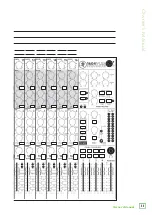
18
1604VLZ4
1604VLZ4
33. Low Cut
This switch, often referred to as a high pass filter (all
depends on how you look at it), cuts bass frequencies
below 75 Hz at a rate of 18 dB per octave. This ain’t no
thrown-in dime-store filter — an 18 dB per octave curve
requires an elaborate circuit. Nothing but the best.
We recommend that you use this on every sound
source except kick drum, bass guitar, or bassy synth
patches. These aside, there isn’t much down there that
you want to hear, and filtering it out makes the low stuff
you do want much more crisp and tasty. Not only that,
but low cut can help reduce the possibility of feedback
in live situations, and it helps to conserve amplifier
power.
With low cut, you can safely boost low EQ. Many
times, bass shelving EQ can really benefit voices.
Trouble is, adding low EQ also boosts the subsonic
debris: Stage rumble, mic handling clunks, wind noise
and breath pops. Low cut removes all that debris so you
can boost the low EQ without blowing your subwoofers.
Here’s a frequency curve of low EQ combined with
low cut:
34. Aux 1, 2, 3, & 4
These four knobs tap a portion of each
channel’s signal, mix them together and
send them to the aux send [6] outputs.
They are off when turned fully down,
deliver unity gain at the center detent,
and can provide up to 15 dB of gain turned
fully up. Chances are you’ll never need
this extra gain, but it’s nice to know it’s
there if you do.
The aux send outputs are then patched
to parallel effects processor inputs or stage
monitor amp inputs. Aux sends 1 and 2
levels are controlled not only by the
channel’s aux knobs, but also by the
aux send [49] master knobs.
Aux sends can also be used to
generate separate mixes for recording
or “mix-minuses” for broadcast. By using
aux 1 or 2 in the pre [35] mode, these
mix levels can be obtained independently
of a channel’s fader [25] settings.
20
Hz
100
Hz
1k
Hz
10k
Hz
20k
Hz
–15
–10
–5
0
+5
+10
+15
33
36
34
35
We recommend going into a stereo reverb in
mono and returning in stereo. We have found
that on most “stereo” reverbs, the second
input just ties up an extra aux send and adds nothing
to the sound. There are exceptions, so feel free to try it
both ways. Should you choose to use two aux sends,
use the “odd” aux (1, 3 or 5) to feed its left input
and the “even” aux (2, 4 or 6) to feed the right input.
Remember, if you’re also dealing with a stereo source
signal, you’ll want to follow the sides — use the odd aux
on the channel carrying the left side and the even aux
on the channel carrying the right.
35. Pre
This switch determines the tap point of aux 1 and 2.
Generally, “post” sends are used to feed effects devices,
and “pre” sends are used to feed your stage monitors.
See the “Pre vs. Post” diagram below. Aux 3 through 6
are always in post mode.
In post mode (switch up), aux 1 and 2 will follow
the EQ [32], low cut [33], fader [25], and mute [30]
settings. If you fade the channel, you fade the send.
This is a must for effects sends, since you want
the levels of your “wet” signals to follow the level
of the “dry.”
In pre mode (switch down), aux 1 and 2 follow the
gain and low cut settings only. EQ, pan, fader, and mute
settings have no effect on the pre sends. This is the
preferred method for setting up stage monitor feeds
— they’ll be controlled independently of the fader and
mute moves.
36. 5/6 Shift
Don’t let the fact that there’s only four aux knobs
per channel fool you — the 1604VLZ4 has six aux
sends [6]. With this 5/6 shift switch up, the knobs
labeled aux 3 and aux 4 deliver their signals to aux
send 3 and 4 outputs. With this switch down, the
signals appear at the aux send 5 and 6 outputs.
We recommend that aux send 3 and 4 be patched into
your “utility” effects, like a short reverb and slap delay;
effects you use all the time. Use aux send 5 and 6 for
“exotic” effects, like harmonizers and multi-tap delays;
they are not likely to be used as often.
INPUT
TRIM
INSERT
LOW
CUT
EQ
PAN
ASSIGN
MUTE
FADER
'POST' SIGNAL
'PRE' SIGNAL
PRE SWITCH
AUX 1
AUX 2
















































